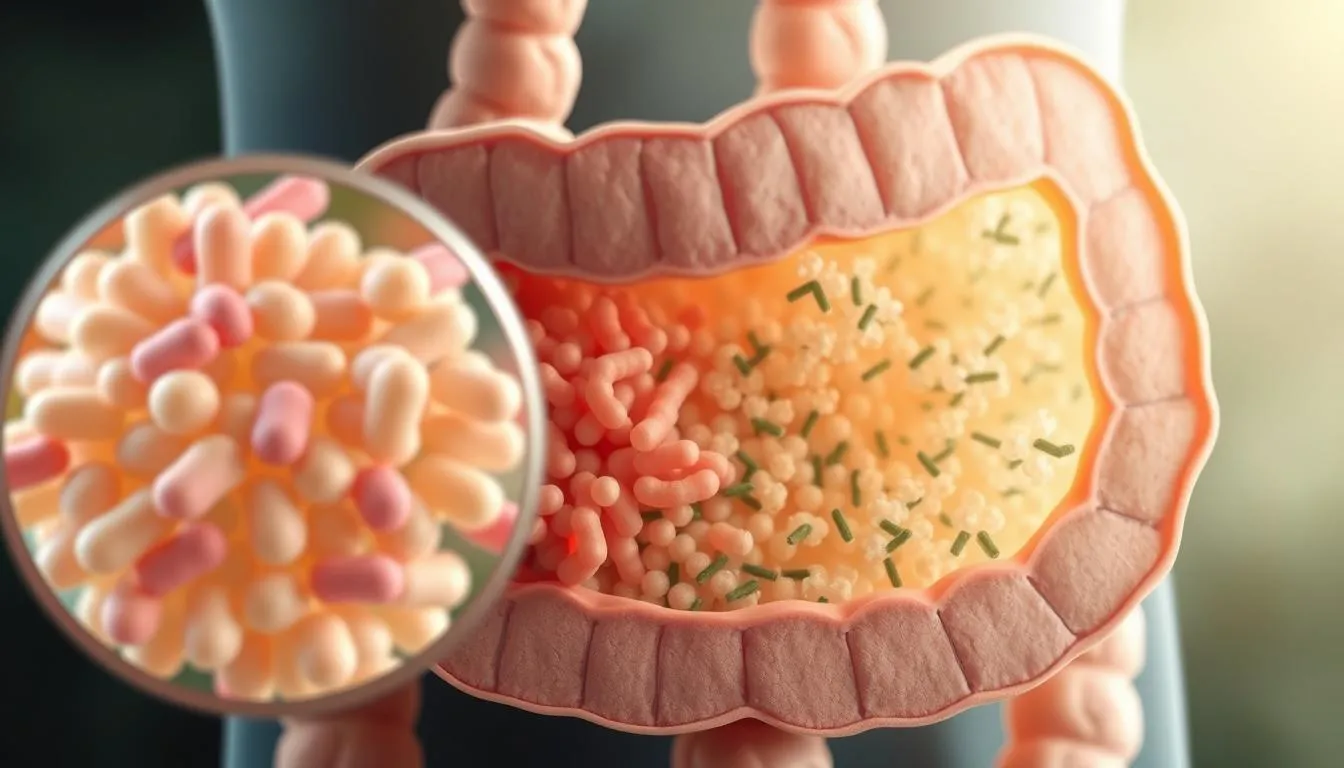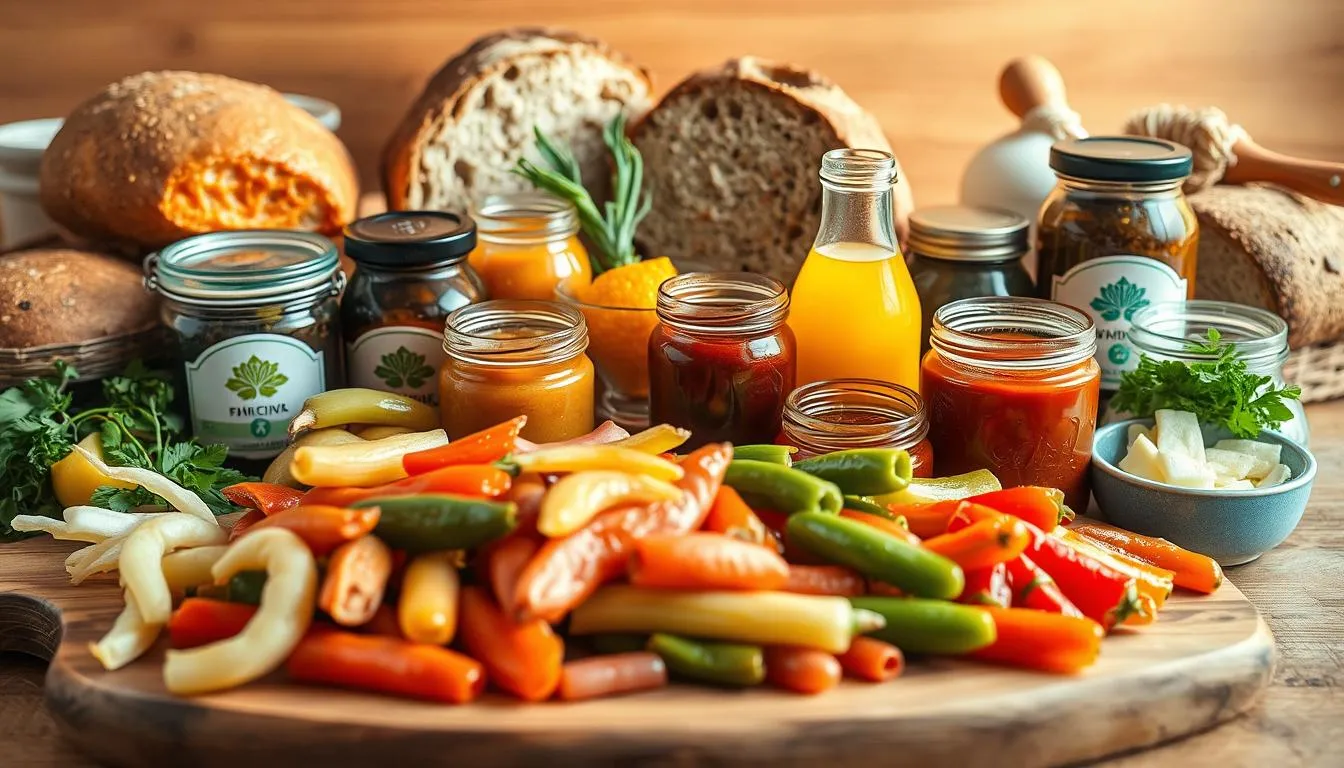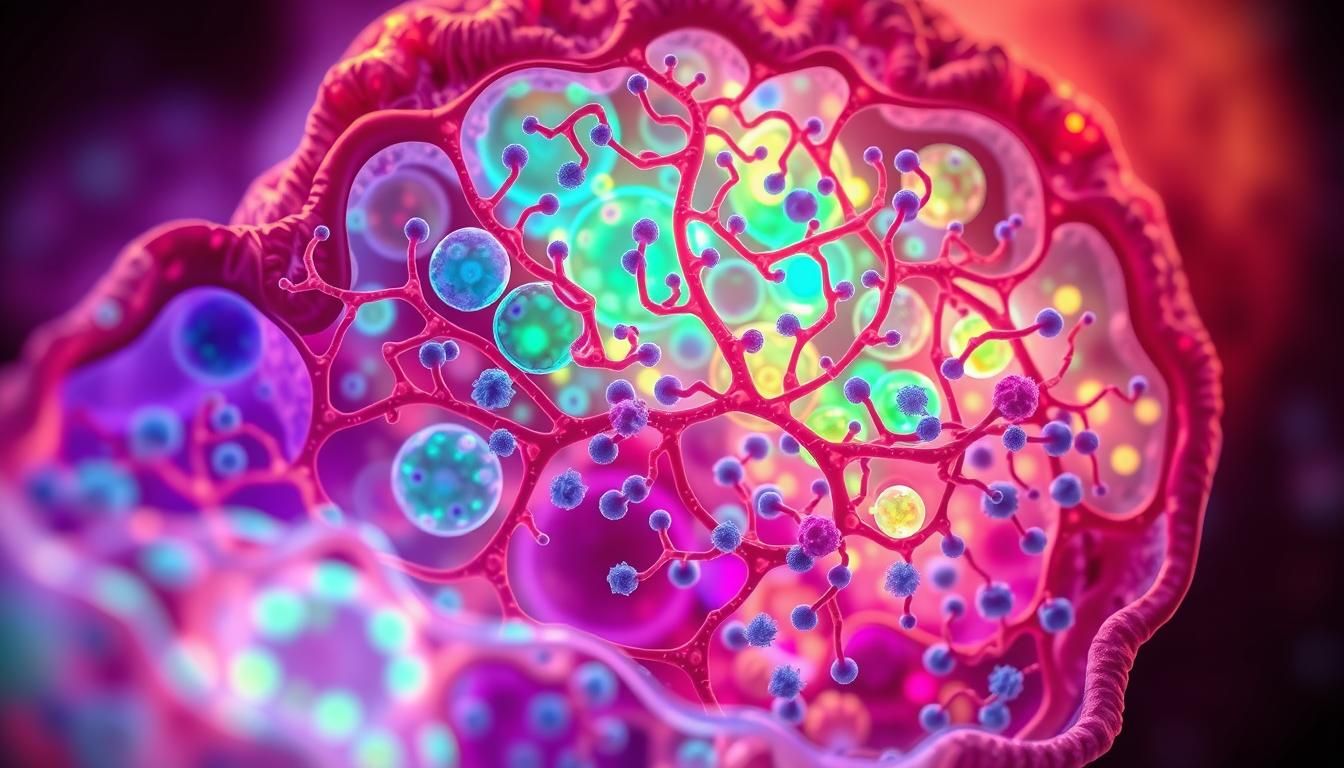I remember the first time my digestion felt truly steady — it changed how I moved through each day. Small food choices helped me sleep better and feel calmer. That shift made me curious about the trillions of microbes inside us and how they shape mood, immunity, and digestion.
This guide shows how simple items in your grocery cart can support a balanced microbiome. You’ll discover what the gut is, why it matters for whole-body health, and which pantry picks add helpful microbes or feed them so they thrive.
We’ll explain live cultures you can eat, the special fibers that fuel those microbes, and how pairing them — synbiotics — can be an easy way to boost resilience. For a practical list of top fiber sources, see this helpful roundup on best prebiotic choices. For more detailed guidance on incorporating functional foods into your diet, read our comprehensive guide on boosting gut health with functional foods. Read on for clear, research-informed tips you can use today.
Key Takeaways
- Small diet shifts can improve digestion, mood, and immune response.
- Live cultures add helpful microbes to the gut; certain fibers feed them.
- Pairing both in meals supports microbial diversity and gut health.
- Look for practical, U.S.-friendly options you can rotate into your diet.
- We’ll highlight where evidence is strong and where more research is needed.
Prebiotics vs. Probiotics: What They Are and How They Work
A clear view of microbes, active cultures, and the fibers that feed them makes gut support practical and doable.
The gut microbiome is a bustling community of about a thousand species of bacteria, yeasts, and other microbes in the lower GI tract. These microbes influence digestion, the immune system, and even mood. Think of this community as a small ecosystem inside your body that benefits from variety and balance.

Live cultures and how they help
Probiotics are specific live microorganisms—often strains of Lactobacillus or Bifidobacterium—that can give health benefits when taken in adequate amounts. You’ll find these in fermented items and many supplement products. Evidence shows that strain, dose, and the person’s diet shape the effect.
Fuel for beneficial microbes
Prebiotics are nondigestible fermentable fibers that serve as food for helpful bacteria. Not every fiber acts this way; the benefit depends on type and amount. Studies compare different fibers to see which microbes respond best.
Why pair them
Synbiotics combine both types in one product or meal to help introduced strains survive and thrive. When a product lists specific microorganisms or cultures, that transparency often matches better evidence. For an overview of combined approaches, see this guide on probiotics and prebiotics.
- Microbe effects depend on strain, dose, and diet.
- Look for named strains on product labels for clearer evidence.
- Pairing adds variety and can boost real-world benefit.
What the Evidence Says: Benefits, Limits, and Safety
Clinical trials give a clear picture for some uses and a murkier one for others.

Antibiotics and antibiotic-associated diarrhea
High-quality reviews show that taking probiotics during antibiotic therapy cuts antibiotic-associated diarrhea by roughly 60% in many trials. This is one of the clearest treatment effects for gut support.
Infant care and severe bowel infections
Large analyses found that targeted use helped prevent necrotizing enterocolitis in preterm infants. That result stands out as a major health benefit in neonatal care.
Irritable bowel syndrome and other GI conditions
For irritable bowel syndrome, research is mixed. Some studies report symptom relief, but results vary by strain, dose, and person.
Broader signals and safety caveats
There are promising signals for immune markers, mood, skin, and metabolic measures, yet the evidence is not consistent across studies.
Note: probiotic supplements are not regulated like drugs, so product contents can differ from labels. For guidance on choosing a clinically studied product, see the NIH professional guide. Seek care if you are immunocompromised, critically ill, or if symptoms worsen.
Prebiotic and probiotic foods
A few everyday grocery items pack powerful microbes and steady fuel for the gut ecosystem.
Fermented choices bring living microorganisms that can add diversity to your gut. Look for yogurt, kefir, kimchi, sauerkraut, miso, kombucha, aged cheeses, sourdough bread, and traditionally fermented pickles.

How to pick products that still contain live cultures
Scan labels for the phrase “live and active cultures”. Refrigerated sauerkraut and pickles are more likely to have living microbes; many shelf-stable jars are pasteurized and lack them.
For guidance on choosing supplements and products with clear labeling, see choosing products with live cultures.
Plant-based fuel for your microbes
Fiber-rich plants feed beneficial bacteria in the gut. Regularly include fruits, vegetables, whole grains, legumes, nuts, and seeds to support those microbes.
U.S.-friendly picks to rotate: oats and barley at breakfast, garlic and onions in savory dishes, bananas and apples for snacks, sweet potatoes as a side, and soybeans (edamame or tofu) to round out meals.
- Combine a fermented item plus a fiber-rich plant at most meals.
- Enjoy yogurt or kefir chilled or stirred in after cooking to protect cultures.
- Start with small servings of kombucha, sauerkraut, or pickles and increase variety week to week.
Beginner’s Guide to Building a Gut-Healthy Plate Today
Building a gut-friendly plate starts with tiny swaps you can keep up week after week. Make small changes so your body and stomach adapt without upset. Rotate choices to add variety and steady benefit.
Start slow: introduce small amounts and rotate a variety of foods
Begin with modest portions of cultured items and high-fiber plants. Add a little each day and note how your stomach feels.
Tip: rotate yogurt, kefir, kimchi, or sauerkraut alongside oats, beans, and cooked onions to build tolerance and variety.
Simple meal ideas: pair fermented foods with fiber-rich plants
- Yogurt with oats and banana for breakfast.
- Kimchi fried rice with cooled brown rice and mixed veggies.
- Miso soup plus edamame as a light lunch.
- Grain bowl: sauerkraut, beans, greens, and seeds.
When to consider probiotic supplements and how to choose
Most healthy people do not need supplements. Consider a probiotic supplement after antibiotics or for specific issues like lactose intolerance or IBS—ask your provider for strain advice.
“Small, consistent habits often deliver the biggest gut health wins.”
Choosing tips: look for named strains, a clear best-by date, storage guidance, and an appropriate CFU count. If symptoms worsen or you are immunocompromised, seek medical care before starting a product.
Conclusion
Small, steady choices at meals can shape how your gut feels day to day.
Make it simple: eat fermented items regularly and pair them with plant-based fiber to feed helpful bacteria and support a diverse microbiome. Read labels for “live and active cultures” and favor refrigerated products when possible so microbes are more likely to be viable.
The strongest evidence shows clear benefit for antibiotic-associated diarrhea and select infant treatments; other uses show promise but vary by product, dose, and your diet. If you consider supplements for a specific treatment or ongoing bowel issues, talk with your healthcare provider first.
Keep variety, notice how you feel, and build a routine you can sustain for lasting benefits to your immune system and daily comfort.
FAQ
What are the key differences between prebiotics and probiotics?
Prebiotics are nondigestible fibers that feed beneficial gut bacteria, while probiotics are live microorganisms found in some fermented products and supplements. Together they support digestion, the immune system, and overall gut balance when paired thoughtfully.
Which fermented items are richest in live cultures?
Yogurt with live and active cultures, kefir, kimchi, sauerkraut (refrigerated varieties), miso, and traditionally brewed pickles offer a variety of beneficial strains. Look for refrigerated labels and phrases like “live cultures” to maximize microbial variety.
Can these products help with antibiotic-associated diarrhea?
Evidence shows certain strains can reduce the risk of diarrhea after antibiotics. Benefits depend on the specific microorganism and dose, so choose evidence-backed strains such as Lactobacillus rhamnosus GG or Saccharomyces boulardii when recommended by a clinician.
Are supplements necessary, or can I get enough from diet?
Many people can support their gut with a varied diet that includes fermented items and fiber-rich plants. Supplements may help in specific cases like recent antibiotic use, IBS, or preterm infant care, but product quality, strain specificity, and medical guidance matter.
What plant choices best feed beneficial bacteria?
Oats, barley, garlic, onions, bananas, apples, sweet potatoes, legumes, nuts, and seeds supply fermentable fibers that nourish the microbiome. Rotate these across meals to encourage diverse microbial support.
How should beginners introduce these foods safely?
Start with small portions and increase gradually to reduce bloating. Rotate different fermented items and fiber sources, pair them in balanced meals, and monitor tolerance. If you have immune compromise or severe illness, consult your healthcare provider first.
Do fermented beverages like kombucha provide the same benefit as yogurt?
Kombucha can offer beneficial microbes but varies widely by brand and brewing practice. Yogurt and kefir consistently supply higher, measurable counts of live cultures and clear nutritional value, making them reliable options.
Can improving gut balance affect mood or skin?
Research suggests connections between gut microbes and outcomes such as mood, skin conditions, and metabolic markers. Effects are often modest and strain-dependent, so dietary changes can help but are not a guaranteed treatment for these concerns.
How do I read labels to pick quality products?
Choose refrigerated items with “live and active cultures” or specific strain names. For supplements, look for third-party testing, clear CFU counts at expiration, and evidence for the listed strains. Avoid products with excessive added sugars.
Are there safety concerns with fermented items or supplements?
Most healthy adults tolerate them well, but people with severe immune suppression, recent surgery, or critical illness should avoid live-culture products unless advised by a physician. Supplements vary in regulation, so prioritize reputable brands and consult your clinician for personalized guidance.
